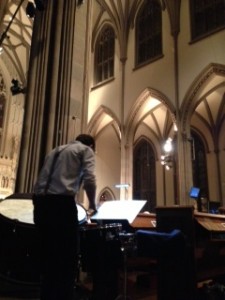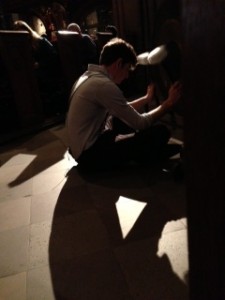
John Luther Adams often seems like an Alaska Impressionist – or so I’ve said in the past, perhaps misleadingly.
The implication of that moniker implies pretty-sounding Arctic Debussy, something more descriptive than Sibelius and surely full of more bears than lions and tigers. In fact, Adams (who lived in Alaska for years) has an all-embracing attitude toward sound that could only have come in the wake of John Cage. His Strange and Sacred Noise, which I caught at a free lunchtime concert at Trinity Wall Street in New York, was performed with the four members of Sandbox Percussion stationed at varying points in the church, often changing instruments and positions. They were all seen on video monitors placed throughout the church in the 80-minute performance.
Adams often takes a journey to the center of the earth, calmly probing the planet for its hum and its roar, and never more so than here, where he eschews typical melody and linear writing in favor of pure sound, percussion instruments blended with an ear as keen as George Crumb’s. Since the concert was free on a rainy Thursday, it became a refuge for 9/11 Memorial tourists who had found their way downtown and stumbled upon sidewalk signs for a free concert – though within ten minutes, families were seen departing in their plastic rain ponchos with fingers stuffed in ears.
The earth, as Adams hears it, can be both subtle and volcanic. The planet makes many sounds, not dissimilar to what Charles Ives was on to in his unfinished Universe Symphony, and not unlike the various forms of space noise that have been captured in what is widely assumed to be in the peace and quiet of outer space. Adams treats his percussion resources with cool, exploring one sonic possibility at a time in the multi-movement piece, each section creating a discrete sound world, each combination of instruments thoughtfully chosen and deployed. I heard ice floes breaking up, the earth cracking open, but also the crevasses and gorges coming together as if in auto-repair mode.
Bicycling across the Brooklyn Bridge to the concert, one had to navigate around extra police stationed on the footpath; ISIS was reportedly planning an attack. While waiting for the light to change on the Manhattan side, a fellow bicyclist and I wondered what good they could actually do. And while one might look to Adams’s music as a sanctuary from all that, Adams isn’t that kind of guy. He embraces the world unconditionally rather than turning away from it – even if that means, just for the sake of variety, his idea of strange and sacred noises includes an unsettling siren halfway through. Or was that coming from the street? Would Adams dispute any claim one way or another?
PS -The video monitors added a nice sense of dislocation: When the percussionist was on the opposite side of the church, you saw the sound being made  a nanosecond before actually hearing it. And here’s the eeriest part: When one of the cameras scanned the audience, I swear I saw, among the listeners, the concert pianist Seymour Lipkin, who was one to unassumingly turn up at church concerts before he passed away earlier this week. Maybe he just didn’t want to miss this one.
a nanosecond before actually hearing it. And here’s the eeriest part: When one of the cameras scanned the audience, I swear I saw, among the listeners, the concert pianist Seymour Lipkin, who was one to unassumingly turn up at church concerts before he passed away earlier this week. Maybe he just didn’t want to miss this one.


I love your writing, David.